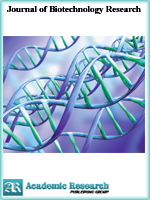Journal of Biotechnology Research
Online ISSN: 2413-3256
Print ISSN: 2413-8878
Print ISSN: 2413-8878
Quarterly Published (4 Issues Per Year)

Archives
Volume 3 Number 10 October 2017
Effects of Two Disinfectants and Two Growth Regulators on in vitro Propagation of Smooth Cayenne and Sugarloaf Cultivars of Pineapple (Ananas comosus (L) Mill var. comosus)
Authors: Badou Bienvenu T. ; Agbidinoukoun Arnaud ; Nondichao Leifi ; Dossoukp?vi Ren? ; Caca? Gilles T. H. ; Hou?djissin Serge S. ; Ahanhanzo Corneille
Pages: 94-105
Abstract
Pineapple is the first fruit crop that greatly contributes to poverty reduction for population in Benin. However, the lack of plant material is the main factor that limits field extension. The aim of this work was to optimize the production of plant material for the two pineapple cultivars by tissue culture technique. Disinfection of the buds was evaluated by using antibiotics (gentamicin at 300 mg/l for 12 hours), and disinfectants (sodium hypochlorite and mercuric chloride) at different doses and immersion duration. Axillary buds of crown were seeded on Murashige and Skoog medium (MS) supplemented with agar (0.8%). Benzylaminopurine (BAP) was tested at different concentrations (5 mg/l and 10 mg/l) or combined with naphthalene acetic acid (NAA) (4.5 mg/l BAP + 0.7 mg/l NAA). Six to eight weeks after initiation, buds were transferred to MS medium supplemented with 1 mg/l BAP + 40 mg/l adenine sulfate. The lowest infection rate (26.07%) was recorded by 15% of Sodium hypochlorite when buds were immersed for 5 min. The best bud burst rate was obtained on BAP combined with NAA (65.09%) with Sugarloaf (64.95%). After the first subculture, an average of 12.70 and 15.30 shoots per plantlet were obtained respectively for Smooth Cayenne and Sugarloaf. The number of rooted plantlets and the length of roots varied depending on the cultivar.
Genotoxic and Biochemica Effects of Consumption of Heavy Metal Contaminated Fish and Its Reversal Using Zinc Supplements in Rats
Authors:
Bolawa O. E. ; Ebuehi O. A. T.
Pages: 85-93
Abstract
Introduction: Heavy metals such as lead, cadmium, chromium etc are environmental contaminants. They are also known today as human and animal carcinogens. Objectives: The aim of the study was to evaluate the genotoxic and biochemical effect of feeding rat with fish obtained from heavy metal contaminated water bodies in Lagos, Nigeria. Methods: DNA damage was investigated using DNA lading assay, while heavy metals and antioxidants were analyzed from fishes obtained from contaminated water bodies. Results: There was fragmentation of blood chromosomal DNA in rats fed with heavy metal contaminated fish, while in the control and zinc supplemented group, there was no fragmentation. Heavy metals were detected in the tissues and serum of exposed rat, while the activity of the serum catalase and reduced glutathione significantly decreased. Conclusion: The consumption of heavy metal contaminated fish resulted in DNA fragmentation and its deposition in the rat tissue. Zinc supplementation prevented the degradation of DNA and potentiated antioxidant activities.
Characterization of Chromophile Fungal Isolates from Landfill Polluted By Tannery Effluent
Authors: Emmanuel S. D. ; Gbolagunte G. O. ; Okoduwa S. I. R. ; Banjo K. ; Sule S. A. ; Balarabe B. M.
Pages: 75-84
Abstract
Background: The release of unprecedented tannery effluents into the environment as industrial wastes is one of the major causes of environmental pollution. Tannery waste containing heavy metals are usually disposed in landfills and streams in Challawa industrial estate Kano. The aim of this study was to characterize chromophile fungal isolated from landfill polluted by tannery effluent. Method: Tannery effluent discharge soil (polluted landfill) and undischarged soil (control) were collected from the surrounding areas of tannery industry. The physicochemical properties of the soil were examined in-situ. The fungal strains were tested for tolerance against chromium sulphate. The degree of tolerance was measured by their mycelia growth length of each respective culture colony and it was compared with control containing no chromium sulphate. Result: A total of eleven fungi species were found in the soil. The most common fungal strains viz., Aspergillus niger, Aspergillus sp, Rhizopus nigricans and Penicillium sp. Aspergillus niger was the most tolerant against chromium sulphate. It exhibit strong radial mycelia growth length from 0-4.0% followed by Rhizopus nigricans and the least was obtain by Penicillium sp. Effect of pH and temperature on tolerance of fungal isolates at 1% chromium concentration using different substrates tested were so effective at pH 4-5 and 32oC respectively. Conclusion: These fungi have shown a high level of tolerance to chromium sulphate tested which makes them so attracted and potential candidates for further investigations regarding their ability to remove metals from contaminated waste waters.



